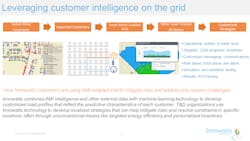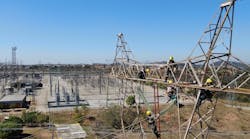As an industry, we have invested billions of dollars to date on advanced metering, data analytics and modeling of our grid assets. While there are many highly successful implementations where data is available for analysis and for decision support in real-time operations, there are also many cases where the data is not as readily available.
Are we flying blind? Many of those who live and breathe the planning and operational realities of today’s rapidly changing infrastructure still believe they are “flying blind”, or at least with very poor eyesight, when it comes to visibility and intelligence on the distribution system. That’s because much of the data, and the potential insights, they need to complete the picture are either still locked up in corporate system or have yet to be harvested from disparate internal systems.
Given the rate of change in the distribution system (technology, market, regulation), gaps in real-time visibility on even some of the distribution systems could put large parts of our grid infrastructure at risk in the not too distant future. The interconnected and interdependent nature of the grid and distributed energy resources means that we may never be much stronger than our weakest neighboring system.
Going forward, our industry will benefit significantly from improved integrated strategies and support for business models for using meter data.
Meter Data Analytics (MDA) has always held a lot of promise, and for some is bearing fruit. For others, the distribution businesses have been hindered by limitations in their ability to use the data effectively. This has often been the result of insufficient bandwidth of the networks to support the needs of operations. The networks were designed to provide a limited subset of available meter data in real time or near real time. Generally, this data was used to support billing and reporting to market operators. For many utilities, the meter data was not correlated against weather at a micro-area level, or against other factors that could be used to predict usage patterns and customer behaviors. For other utilities, there was or is incomplete saturation of AMI, thus providing a seemingly limited view of the system in real time
The growth in sophistication of MDA has led to a host of added benefits that can be derived from metering data. We only need look to those that use MDA and Advanced MDA to hedge energy trading risk, to see the significant value that can be produced from highly accurate, customer level usage forecasts. Isn’t it time that we leverage these capabilities to sharpen our insights into the grid?
Infrastructure requirements, for the most part, are dictated by the following basic factors:
- installed capacity of our infrastructure,
- demand placed on the assets in forward planning cycles,
- condition and performance of these network assets against needs,
- climatic and other environmental forces and events
- interaction with customers regarding Energy Efficiency, Demand Response and Distributed Energy Resources
The industry has become sophisticated in its ability to understand several of these factors, but only through the limited lens of looking “down” network. In the past, with one way flow of energy this downward view was sufficient. The problem we are encountering now is that a lot of our planning and operational decisions are based on a very dynamic mix of supply and delivery assets that is continuously changing. Often our demand assumptions are at best dated and in many cases simply not available. While this downward looking approach may continue to serve some purposes, it doesn’t answer the real questions that planners need to answer. “At 50,000 above the clouds, everything can look pretty good, but once you get on the final approach things can look dramatically different”.
Most utilities can forecast accurately to the substation level, and for some, even that is becoming more difficult to accurately predict. In diverse ways, utilities are actively exploring tools and techniques to improve their visibility out on the distribution system. Many utilities still project demand using a small handful of “deemed” load profiles which essentially means that an entire segment of the population is “assumed” to have a similar pattern of consumption. And we just know that isn’t the case, and that the forecasts are beginning to diverge rapidly from those traditional assumptions. The industry is basing billions of dollars of network investments on techniques that are old and often obsolete, and load forecasting is one of the biggest culprits.
How to learn what we don’t know - Improve BTM Transparency
Advanced MDA is enabling us to effectively see Behind the Meter (BTM), without having to go behind the meter. As an example, Innowatts, LLC, an energy technology out of Houston, TX has been working with several utilities to increase BTM transparency around customer consumption and behavioral intelligence. While the first customers for their Advance MDA were the energy trading and risk hedging community, the more forward thinking distribution operators saw significant promise in applying the BTM capabilities to their areas of focus.
They have developed a unique approach to bottoms up load forecasting. Several of the most promising capabilities that this opens for distribution system asset managers, planners and operators include:
- Customer level forecasts. Linked to GIS, these can provide highly granular visibility into the network in real time. Innowatts has demonstrated that we can get accurate forecasts of consumption; Secondary Voltages; and Aggregated load at the secondary, up to the primary. All of these would support scenario analysis of topology changes (forecast and real time) to examine loading impacts as well as voltage and voltage regulation variances due to planned or reactive changes in the network configuration.
- BTM visibility. Ability to understand what DERs live behind the meter, without the need for going behind the meter. This enables us to see and predict customer behavior patterns and use these to accurately forecast customer energy consumption in real time.
- Recognition of "clusters" of usage patterns. Being able to see and understand the range of clusters and how these clusters change on a seasonal basis, enables stronger collaboration between EE/DR programs and planners. It enables us to target specific EE/DR interventions at a specific customer level that can enhance the grid. It also enables meaningful engagement with specific customers that will have an impact on their usage and their costs of energy. It reduces program costs by avoiding generic or shotgun approaches that often has customers receiving offers that are irrelevant to their concerns.
Beyond these basics, there are even more powerful implications that could have far reaching impacts on reducing the costs for utilities and their customers. For example, Advanced MDA has the potential for creation of highly accurate real-time forecasts, even without real time meter data from all accounts. This could overcome constraints associated with network bandwidth or limited AMI saturation.
Such capabilities would facilitate accurate forecasts without the need to invest in more metering or more sensors on the network, which would be of great benefit for those utilities with limited capacity to make such investments.
Many utilities have begun using their meter data to better support planning and operations. That said, significant additional value to be gained by using these advanced MDA and accurate BTM capabilities. Investments in advanced MDA and BTM are worthy of consideration due to their large potential returns, which help leverage prior investments in AMI at a fraction of those earlier costs.




